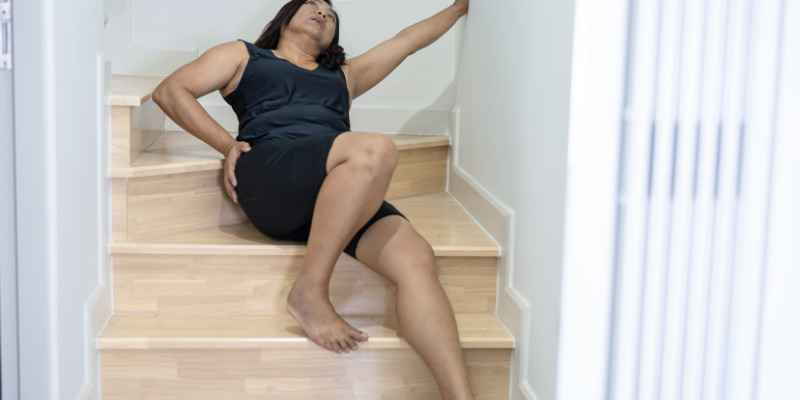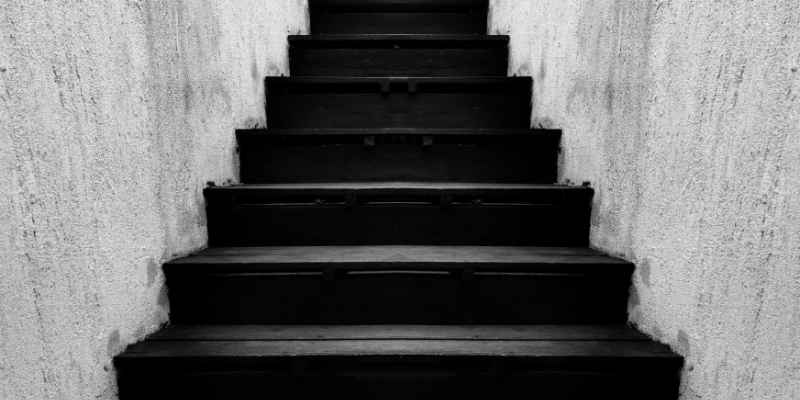To make wood stairs less slippery, you can use non-slip adhesive strips or apply a non-slip solution to the surface. Wood stairs can be dangerous, especially when they are slippery.
Whether due to moisture, dirt, or wear and tear, slippery stairs pose a risk of accidents and injuries. Luckily, there are several effective ways to make wood stairs less slippery. One option is to apply non-slip adhesive strips to the surface of each step, providing added traction and grip.
Another solution is to use a non-slip solution, such as a clear anti-slip coating or adhesive grip tape. These products can be easily applied to the wood surface, enhancing traction without compromising the appearance of the stairs. By taking these steps to reduce slipperiness, you can make your wood stairs safer and more secure for everyone to use.
Why Are Slippery Wood Stairs Dangerous?
Slippery wood stairs can be dangerous as they can cause accidents and falls. To make wood stairs less slippery, you can use non-slip tread covers, apply anti-slip coatings, or add carpet runners for better traction and safety.
Wood stairs can be aesthetically pleasing, but they can also pose a serious safety risk if they become slippery. Slippery wood stairs can lead to slips, trips, and falls, which can result in injuries ranging from minor cuts and bruises to more severe fractures and head trauma. This is particularly dangerous in high-traffic areas such as homes, offices, or public spaces, where accidents are more likely to occur. Understanding the reasons behind the slipperiness of wood stairs is essential in order to make them safer for everyday use.
Improper Traction
One of the main reasons why wood stairs become slippery is the lack of proper traction. Wood is naturally smooth, and over time, the surface of the stairs can become worn out and polished, making it even more slippery. Without sufficient grip, it becomes difficult for individuals to maintain their balance while ascending or descending the stairs. As a result, accidents can happen in a split second, causing injury to unsuspecting users.
Common Causes Of Slipperiness
Several factors contribute to the slipperiness of wood stairs. Let’s take a look at some of the most common causes:
1. Moisture: Moisture is a major culprit when it comes to slippery wood stairs. Whether it’s rainwater being tracked in from outside, spilled liquids, or high humidity levels, moist wood surfaces can quickly become hazardous. The water creates a film between the shoes and the wood, reducing the friction and increasing the chances of slipping.
2. Dirt and debris: Dust, dirt, and debris can accumulate on wood stairs, creating a layer of particles that further reduce traction. When stepped on, these particles can act as small pebbles, causing shoes to lose grip and increasing the risk of accidents.
3. Worn-out protective finish: The protective finish on wood stairs, such as varnish or polyurethane, can wear off over time due to foot traffic and cleaning. This exposes the wooden surface, making it susceptible to moisture absorption and decreasing its slip-resistance.
4. Improper cleaning products: Using incorrect cleaning products or excessive wax on wood stairs can leave a residue that makes the surface slippery. It’s important to use products specifically designed for wood and to follow the manufacturer’s instructions to maintain the stairs’ slip-resistant qualities.
By addressing these common causes of slipperiness and taking appropriate measures, wood stairs can be made safer for everyone. From regular cleaning and maintenance to applying slip-resistant treatments, there are various strategies to improve traction on wood stairs and minimize the risk of accidents.

Assessing The Condition Of Your Wood Stairs
Before you begin the process of making your wood stairs less slippery, it’s essential to assess their current condition. This step will help you identify any wear and tear, determine the type of wood used, and ultimately guide you in choosing the most suitable solution.
Inspecting For Wear And Tear
The first thing you want to do is carefully inspect each step to check for any signs of wear and tear. This includes looking for cracks, splinters, or any unevenness that could pose a safety hazard.
Here are some key areas to pay attention to during your inspection:
- The tread: Examine the horizontal surface of each step. Look for any worn-out spots or deep scratches that might affect the grip.
- The riser: Don’t overlook the vertical surface between each step. Check for any loose or damaged risers that need to be repaired or replaced.
- The nosing: This is the edge of the step that extends slightly beyond the riser. Ensure it is intact and doesn’t pose a tripping hazard.
- The handrail: If your staircase has a handrail, inspect it for stability. Make sure it’s firmly attached and doesn’t have any loose parts that need attention.
Identifying The Type Of Wood
Knowing the type of wood used for your stairs is crucial in determining the best approach to make them less slippery. Different wood species have varying levels of natural grip and durability.
Here are some common types of wood used for stairs:
| Wood Type | Characteristics |
|---|---|
| Oak | Durable and commonly used for stairs. Provides good grip. |
| Maple | Hard and smooth. It might require additional measures to enhance grip. |
| Walnut | Beautiful and durable option but can be slippery. Extra precautions may be needed. |
| Pine | Softwood prone to wear and tear. Grip enhancement might be necessary. |
By identifying the specific wood type, you can narrow down the appropriate solutions that will work best for your stairs.
Now that you have assessed the condition of your wood stairs and identified the type of wood, you are ready to move on to the next step—treating your stairs to make them less slippery.
Preventing Slipperiness With Regular Maintenance
Regular maintenance of wood stairs is essential to prevent slipperiness and ensure the safety of everyone using them. By following these steps, you can make your wood stairs less slippery and minimize the risk of accidents:
Sanding And Refinishing
Sanding and refinishing is an effective way to enhance the traction of wood stairs and reduce their slipperiness. Follow these steps:
- Start by sanding the surface of the stairs using fine-grit sandpaper, which will help to remove any existing finish.
- Once the surface is smooth, wipe away any dust and debris using a damp cloth.
- Next, apply a coat of non-slip varnish or polyurethane to the stairs. This will create a protective layer and add grip.
- Allow the varnish to dry completely before using the stairs again.
Applying Anti-slip Coatings
Another effective method to reduce slipperiness is by applying anti-slip coatings. Follow these steps:
- Clean the stairs thoroughly to remove any dirt or dust.
- Choose an anti-slip coating suitable for wood surfaces. There are many options available, such as non-slip tape, adhesive stair treads, or anti-slip paint.
- Apply the chosen coating to the stairs, following the manufacturer’s instructions. Make sure to cover the entire surface area, including the edges of each step.
- Allow the coating to dry completely before using the stairs again.
Fixing Loose Or Damaged Treads
Loose or damaged treads can contribute to the slipperiness of wood stairs. By fixing them promptly, you can ensure a safer staircase. Follow these steps:
- Inspect each step to identify any loose or damaged treads.
- Tighten any loose screws or nails that are causing the treads to be unstable.
- If the treads are damaged beyond repair, replace them with new ones.
- Make sure the treads are securely attached to the staircase, providing a stable and non-slip surface.
By following these steps and incorporating regular maintenance into your staircase care routine, you can make your wood stairs less slippery and create a safer environment for everyone.
Improving Traction On Wood Stairs
Looking to improve traction and make your wood stairs less slippery? Follow these tips to enhance safety and prevent accidents on your stairs.
Wood stairs can be a beautiful addition to any home, but their smooth surface can also make them slippery and potentially dangerous. Improving traction on wood stairs is crucial to prevent slips and falls. There are several effective methods you can use to enhance the grip and ensure the safety of your stairs. In this article, we will discuss three popular options: installing non-slip tread covers, using adhesive anti-slip tape, and applying non-slip paint.
Installing Non-slip Tread Covers
One of the easiest ways to make wood stairs less slippery is by installing non-slip tread covers. These covers are designed specifically to provide grip and minimize the risk of accidents. Tread covers are typically made of rubber or anti-slip materials that offer excellent traction. They are available in various sizes, styles, and colors to suit different staircase designs. Installing non-slip tread covers is a straightforward process that can be done by following a few simple steps:
- Clean the surface of your wood stairs thoroughly, removing any dirt or debris.
- Measure the dimensions of each stair tread to ensure a perfect fit for the non-slip covers.
- Apply a high-quality adhesive on the back of the tread cover.
- Place the tread cover firmly onto the stair tread, starting from the bottom and working your way up.
- Press down firmly to ensure proper adhesion.
- Repeat the process for each stair tread.
Installing non-slip tread covers not only improves the traction of your wood stairs but also adds a stylish and durable element to your staircase.
Using Adhesive Anti-slip Tape
Another effective method for enhancing traction on wood stairs is using adhesive anti-slip tape. This tape is specially designed with abrasive particles that provide grip and prevent slips. It is an affordable and easy-to-use solution that can be applied to both indoor and outdoor stairs. Here’s how you can use adhesive anti-slip tape to make your wood stairs safer:
- Clean the surface of your stairs, ensuring it is dry and free from dust.
- Measure the length of each stair tread and cut the anti-slip tape accordingly.
- Peel off the backing from the tape and align it with the edge of the stair tread.
- Press down firmly to ensure a secure bond.
- Smooth out any wrinkles or air bubbles for a neat and effective application.
- Repeat the process for each stair tread.
Adhesive anti-slip tape provides an immediate solution to make your wood stairs less slippery, improving safety for you and your family.
Applying Non-slip Paint
If you prefer a more permanent solution, applying non-slip paint to your wood stairs can be an excellent option. Non-slip paint is specially formulated with additives that create a textured surface, enhancing traction even in wet conditions. Here’s a step-by-step guide to applying non-slip paint on your wood stairs:
- Clean the surface of your stairs thoroughly to remove any dirt or residue.
- Fill any cracks or damaged areas with wood filler and let it dry completely.
- Apply a primer to ensure good adhesion of the non-slip paint.
- Use a roller or brush to apply the non-slip paint evenly on each stair tread.
- Allow sufficient drying time between coats as per the manufacturer’s instructions.
- Apply multiple coats for a more durable and slip-resistant finish.
By applying non-slip paint to your wood stairs, you not only improve traction but also add a visually appealing element to your staircase.
Improving the traction of wood stairs is essential to ensure the safety of everyone in your home. Whether you choose to install non-slip tread covers, use adhesive anti-slip tape, or apply non-slip paint, each method offers an effective solution to make your wood stairs less slippery. Choose the option that suits your needs and enjoy a safer staircase without compromising on style.
Other Safety Measures For Wood Stairs
When it comes to maintaining safety in your home, wood stairs require special attention. While we may have already covered some effective ways to make your wood stairs less slippery in a previous section, there are other safety measures you can take to further enhance the safety of your stairs.
Installing Handrails And Balusters
Handrails and balusters are essential components of wood stairs that not only provide support but also help prevent accidents. Installing handrails on both sides of your stairs ensures that individuals of all ages can have something to hold onto while ascending or descending the steps, thereby reducing the risk of slips and falls.
In addition to handrails, balusters are vertical posts that act as a barrier to prevent people from falling off the sides of the stairs. These can be installed between the handrail and the stair tread or between handrails on a balcony or landing. Balusters are available in various styles and materials, allowing you to choose a design that complements your home while providing the necessary safety features.
Improving Lighting On The Stairs
Proper lighting is crucial for preventing accidents on wood stairs. Insufficient lighting can make it difficult to see the steps clearly, increasing the chances of slips and falls. To improve the lighting on your stairs, consider the following options:
- Install overhead lights or recessed lighting fixtures that illuminate the entire staircase.
- Utilize wall sconces or decorative lighting fixtures along the stairwell to provide additional visibility.
- Use motion-sensor lights that automatically turn on when someone approaches the stairs, ensuring visibility even in low-light conditions.
By improving the lighting, you not only enhance the safety of your wood stairs but also create a more welcoming and aesthetically pleasing environment in your home.

Frequently Asked Questions Of How To Make Wood Stairs Less Slippery
How Do You Fix Slippery Wooden Stairs?
To fix slippery wooden stairs, follow these steps:
1. Clean the stairs thoroughly to remove any dirt or debris.
2. Apply an anti-slip solution or paint to the stairs for added traction.
3. Consider installing non-slip adhesive strips or mats on each step.
4. Use a sandpaper or grip tape to create texture on the surface of the stairs.
5. Regularly maintain the stairs by cleaning and re-applying any anti-slip solutions as needed.
How Do I Make My Hardwood Stairs Less Slippery For My Dog?
To make hardwood stairs less slippery for your dog, you can apply adhesive stair treads or non-slip stair tape. Another option is to add carpet or rugs to the stairs. Additionally, you can use a grip-enhancing spray or apply a non-slip clear coating to the stairs for added traction.
How Do You Reduce Slip Stairs?
To reduce slip stairs, follow these steps:
1. Keep stairs clean and free from debris.
2. Install slip-resistant treads or mats for added grip.
3. Use handrails for support and stability while using stairs.
4. Ensure proper lighting to see each step clearly.
5. Consider applying an anti-slip coating or paint on the stairs.
How Do You Make Anti-slip Steps?
To make anti-slip steps, follow these guidelines:
1. Use non-slip paint or adhesive strips on the steps.
2. Install rubber or grip-enhancing mats on each step.
3. Apply a non-slip coating to the steps.
4. Keep the steps clean and free of debris.
5. Consider installing handrails for added safety.
Conclusion
Implementing these practical tips can greatly reduce the slipperiness of wood stairs. By using tread covers, adding grip strips, applying non-slip paint or varnish, or utilizing adhesive stair mats, you can create a safer environment for yourself and your loved ones.
Remember, safety should always be a priority when it comes to home improvement projects. Make your wood stairs slip-resistant and give yourself peace of mind.


